Subaru Legacy 2023 Vehicle In Case Of An Emergency Touring XT
With its integrated emergency parking brake, the 2023 Subaru Legacy Touring XT provides a dependable and safe emergency parking option. When parking, this feature lets drivers manually apply the brake, giving them more confidence that the car will stay still—especially on hills or with the transmission in “Park.” Subaru makes sure that the emergency parking brake is simple for the driver to activate and release, increasing convenience and reducing anxiety when parking in an emergency. This attention to safety comes first. The emergency parking brake on the Legacy Touring XT is a trustworthy safety element that helps provide a secure and confident parking experience, regardless of the situation—a steep hill or a routine halt.
2024 Subaru Legacy Specs, Price, Features, Mileage (Brochure)
If you park your vehicle in case of an emergency
The hazard warning flasher should be used in day or night to warn other drivers when you have to park your vehicle under emergency conditions. Avoid stopping on the road. It is best to safely pull off the road if a problem occurs. The hazard warning flasher can be activated regardless of the ignition switch position. Turn on the hazard warning by pushing the hazard warning flasher switch. Turn it off by pushing the switch again.
NOTE
When the hazard warning flasher is on, the turn signals do not work.
Temporary spare tire
When a spare tire is mounted or a wheel rim is replaced without the original pressure sensor/transmitter being transferred, the low tire pressure warning light will illuminate steadily after blinking for approximately one minute. This indicates the tire pressure monitoring system (TPMS) is unable to monitor all four road wheels. Contact your SUBARU dealer as soon as possible for tire and sensor replacement and/or system resetting.
CAUTION
Never use any temporary spare tire other than the original. Using other sizes may result in severe mechanical damage to the drive train of your vehicle. The temporary spare tire is smaller and lighter than a conventional tire and is designed for emergency use only. Remove the temporary spare tire and re-install the conventional tire as soon as possible because the spare tire is designed only for temporary use. Check the inflation pressure of the temporary spare tire periodically to keep the tire ready for use. The correct pressure is 60 psi (420 kPa, 4.2 k gf/cm2). When using the temporary spare tire, note the following.
- Drive with caution when the temporary spare tire is installed. Avoid hard acceleration and braking, or fast cornering, as control of the vehicle may be lost.
- Do not exceed 50 mph (80 km/h).
- Do not put a tire chain on the temporary spare tire. Because of the smaller tire size, a tire chain will not fit properly.
- Do not use two or more temporary spare tires at the same time.
- Do not drive over obstacles. This tire has a smaller diameter, so road clearance is reduced.

- Tread wear indicator bar
- Indicator location mark
- When the wear indicator appears on the tread, replace the tire.
- The temporary spare tire must be used only on the rear wheel. If a front wheel tire gets punctured, replace the wheel with a rear wheel and install the temporary spare tire in place of the removed rear wheel.
Maintenance tools
Your vehicle is equipped with the following maintenance tools.
- Jack
- Jack handle
- Screwdriver
- Towing hook (eye bolt) Outback/ Subaru Outback Wilderness)
- Wheel nut wrench
- Torque wrench (Outback)
CAUTION
The torque wrench is designed to be used only when changing the position of the crossbar. Do not use the torque wrench in other cases. Otherwise, the torque wrench may be deformed.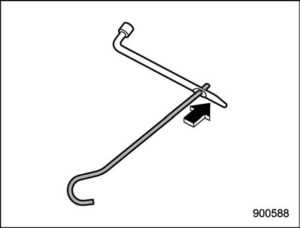
NOTE
To use the jack handle, insert the jack handle into the hole of the wheel nut wrench.
Legacy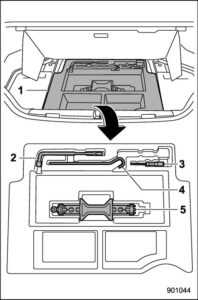
- Under-floor storage compartment
- Wheel nut wrench
- Screwdriver
- Jack handle
- Jack
The maintenance tools are stored in the under-floor storage compartment.
Outback/Subaru Outback Wilderness
Type A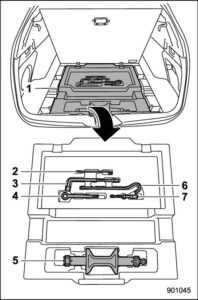
- Under-floor storage compartment
- Torque wrench for roof rails
- Wheel nut wrench
- Towing hook (eye bolt)
- Jack
- Jack handle
- Screwdriver
The maintenance tools are stored in the under-floor storage compartment.
Type B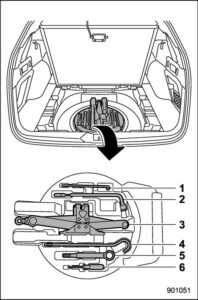
- Torque wrench for roof rails (if equipped)
- Wheel nut wrench
- Jack
- Jack handle
- Towing hook (eye bolt)
- Screwdriver
Flat tires
If you have a flat tire while driving, never brake suddenly; keep driving straight ahead while gradually reducing speed. Then slowly pull off the road to a safe place.
Changing a flat tire
- Use only the jack and the jack handle provided with your vehicle. The jack supplied with the vehicle is designed only for changing a tire. Never get under the vehicle while supporting the vehicle with this jack
- Do not jack up the vehicle on an incline or a loose road surface. The jack can come out of the jacking point or sink into the ground and this can result in serious injury or death.
- Before jacking up the vehicle, be sure that there are no occupants or cargo on board.
- Do not jack up the vehicle with an object on or underneath the jack. The jack can be unstable and this can result in a severe accident.
- Always turn off the engine before raising the flat tire off the ground using the jack.
- Never swing or push the vehicle supported with the jack. The jack can come out of the jacking point due to a jolt and this can result in serious injury or death.
- All passengers must exit the vehicle before you raise it with the jack. Raising the vehicle with someone inside of it could result in serious injury or death.
- Do not start the vehicle while it is supported by the jack
- Doing so could result in serious injury or death.
CAUTION
Do not hit and bend the disc rotor backing plate when removing and installing the tire. A bent backing plate may scrape against the disc rotor and cause noise while the vehicle is in motion.
NOTE
Contact a SUBARU dealer when jacking up the vehicle using a garage jack.
- Park on a hard, level surface, whenever possible, then stop the engine.
- Apply the parking brake securely and shift the shift lever in reverse (MT models) or the select lever to the “P” (Park) position (CVT models).
- Turn on the hazard warning flasher and unload all occupants and luggage from the vehicle.

- Put wheel blocks at the front and rear of the tire diagonally opposite the flat tire.
- Take out the jack, jack handle and wheel nut wrench.1. Park on a hard, level surface, whenever possible, then stop the engine.
NOTE
- Make sure that the jack is well lubricated before using it.
- To take out the tools and spare tire, store the cargo area cover to the original position and open the under-floor storage.
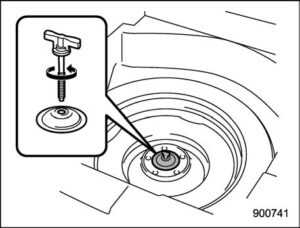
- Take out the tool bucket and turn the attaching bolt counterclockwise, then take the spare tire out.
NOTE
Carefully read Temporary Spare Tire and strictly follow the instructions.
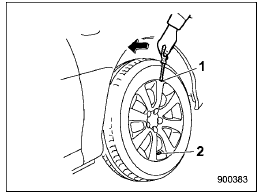
- Notch
- Valve hole
- If your vehicle has wheel covers, insert a flat-head screwdriver into the notch on the opposite side of the valve hole and pry the wheel cover to remove it.
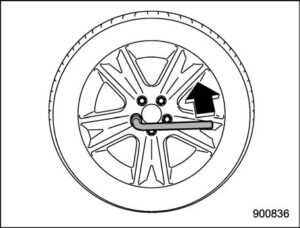
- Loosen the wheel nuts using the wheel nut wrench but do not remove the nuts.

- Place the jack under the side sill at the front or rear jack-up point closest to the flat tire.
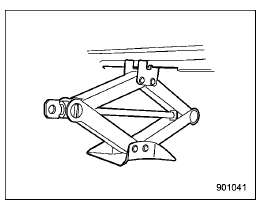
- Turn the jackscrew by hand until the jack head engages firmly into the jack-up point.

- Insert the jack handle into the hole of the wheel nut wrench.
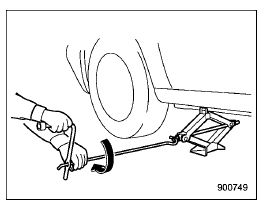
- Insert the jack handle into the jack screw, and turn the handle until the tire clears the ground. Do not raise the vehicle higher than necessary.
- Remove the wheel nuts and the flat tire.


- Before putting the spare tire on, clean the mounting surface of the wheel and hub with a cloth.
- Put on the spare tire. Replace the wheel nuts. Tighten them by hand.
WARNING
Do not use oil or grease on the wheel studs or nuts when the spare tire is installed. This could cause the nuts to become loose and lead to an accident. - Turn the jack handle counterclockwise to lower the vehicle.

- Use the wheel nut wrench to securely tighten the wheel nuts to the specified torque, following the tightening order in the illustration. Never use your foot on the wheel nut wrench or a pipe extension on the wrench because you may exceed the specified torque. Have the wheel nut torque checked at the nearest automotive service facility.
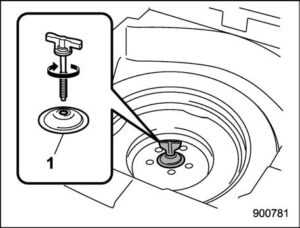
- Support holder
- Store the flat tire in the spare tire compartment. Install with the support holder facing upward and secure the flat tire by firmly tightening the attaching bolt.
NOTE
If you cannot fix the flat tire firmly, try turning the support holder upside down. - Store the jack, jack handle, and wheel nut wrench in their storage locations.
NOTE
If the spare tire provided in your vehicle is a temporary spare tire, carefully read “Temporary spare tire” 9-2 and strictly follow the instructions.
WARNING
Never place a tire or tire-changing tools in the passenger compartment after changing wheels. In a sudden stop or collision, loose equipment could strike occupants and cause injury. Store the tire and all tools in the proper place.
Tire pressure monitoring system (TPMS) (U.S.-spec. models)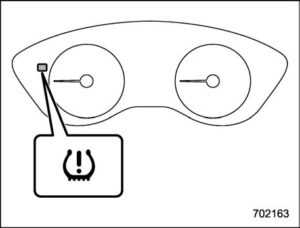
Low tire pressure warning light
The tire pressure monitoring system provides the driver with the warning message indicated by sending a signal from a sensor that is installed in each wheel when tire pressure is severely low. The tire pressure monitoring system will activate only when the vehicle is driven. Also, this system may not react immediately to a sudden drop in tire pressure (for example, a blow-out caused by running over a sharp object).
WARNING
- If the low tire pressure warning light illuminates while driving, never brake suddenly. Instead, perform the following procedure. Otherwise, an accident involving serious vehicle damage and serious personal injury could occur.
- Keep driving straight ahead while gradually reducing speed.
- Slowly pull off the road to a safe place.
- Check the pressure for all four tires and adjust the pressure to the COLD tire pressure shown on the vehicle placard on the door pillar on the driver’s side.
- If this light still illuminates while driving after adjusting the tire pressure, a tire may have significant damage and a fast leak that causes the tire to lose air rapidly
- If you have a flat tire, replace it with a spare tire as soon as possible.. When a spare tire is mounted or a wheel rim is replaced without the original pressure sensor/transmitter being transferred, the low tire pressure warning light will illuminate steadily after blinking for approximately one minute. This indicates the TPMS is unable to monitor all four road wheels. Contact your SUBARU dealer as soon as possible for tire and sensor replacement and/or system resetting.
- When a tire is repaired with liquid sealant, the tire pressure warning valve and transmitter may not operate properly. If a liquid sealant is used, contact your nearest SUBARU dealer or another qualified service shop as soon as possible. Make sure to replace the tire pressure warning valve and transmitter when replacing the tire. You may reuse the wheel if there is no damage to it and if the sealant residue is properly cleaned off. If the light illuminates steadily after blinking for approximately one minute, promptly contact a SUBARU dealer to have the system inspected
TPMS Screen (U.S.-Spec. Models)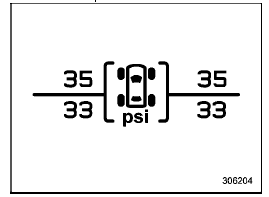
FAQ
Does the 2023 Subaru Legacy Touring XT come equipped with an emergency parking brake?
Yes, the Legacy Touring XT typically features an emergency parking brake, also known as a handbrake or e-brake.
How is the emergency parking brake engaged in the Legacy Touring XT?
The emergency parking brake is usually engaged by pulling up on a lever or pressing a button in the center console.
What is the purpose of the emergency parking brake in the Legacy Touring XT?
The emergency parking brake is primarily used to secure the vehicle in place when parked, especially on inclines or when the transmission is in “Park.”
Can the emergency parking brake be manually disengaged by the driver?
Yes, the driver can typically release the emergency parking brake by pressing a button, pulling a lever, or activating a switch.
Is there an indicator or warning light to inform the driver when the emergency parking brake is engaged?
Yes, the Legacy Touring XT typically has a warning light on the dashboard to indicate when the emergency parking brake is engaged.
Can the emergency parking brake be used in conjunction with the vehicle’s regular brakes for added security?
Yes, it can provide additional security when parking on steep slopes or to prevent unintended movement.
Does the Legacy Touring XT have an automatic parking brake feature?
Some models may offer an automatic parking brake feature that engages the brake when the vehicle is turned off or shifted into “Park.”
What precautions should be taken when using the emergency parking brake in winter or icy conditions?
It’s essential to use the parking brake judiciously in icy conditions to prevent it from freezing or sticking.
Can the emergency parking brake be used as an emergency stopping mechanism while driving?
The emergency parking brake is not designed for emergency stopping while driving and should not be used as a substitute for the regular brakes.
How does the Legacy Touring XT ensure the emergency parking brake is released before driving?
Most modern vehicles have a safety interlock system that requires the brake to be disengaged before the vehicle can be moved.
Is there a recommended procedure for engaging the emergency parking brake when parking on a hill?
It’s advisable to engage the brake before shifting into “Park” when parking on a hill for added security.
Does the Legacy Touring XT have any features related to automatic parking or parking assistance?
Some models may offer advanced parking assist features, but these are separate from the emergency parking brake.
What maintenance or inspections should be performed on the emergency parking brake?
Regular inspections and lubrication may be necessary to ensure the emergency parking brake functions correctly.
Can the emergency parking brake be used in conjunction with the regular brakes for emergency braking in certain situations?
While it can provide additional stopping force, it should not be relied upon as the primary method for emergency braking, as regular brakes are more effective.
Is there a recommended procedure for disengaging the emergency parking brake after a period of non-use?
It’s advisable to engage and disengage the brake periodically to prevent it from sticking when not in regular use.
Useful Link
View Full User Guide: Subaru Legacy 2023 Touring XT User Guide
Download Manuals: https://www.subaru.com/owners/vehicle-resources/manuals.html
2024 Subaru Legacy Specs, Price, Features, Mileage (Brochure)


